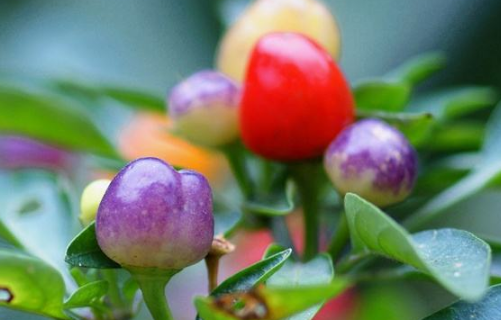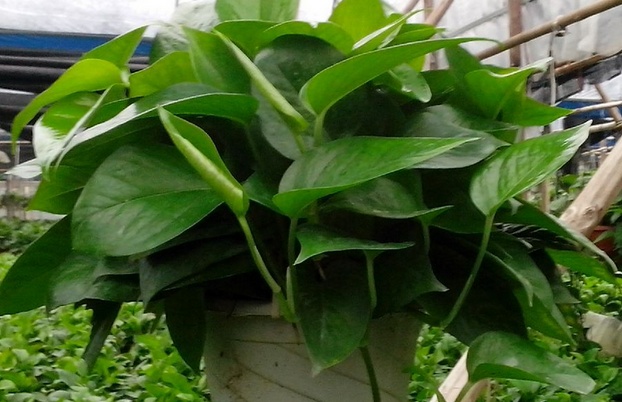Matters needing attention in culturing colorful pepper
1. When potted colorful peppers, generally choose an appropriate amount of pots, and there must be drainage holes under the flowerpots, otherwise it will hinder root respiration if it is not conducive to drainage.

2. Colorful peppers are easier to raise. Find some fertile soil and don't even need to apply fertilizer. However, if you apply more urea and spray Yemanbao and other fertilizers at the beginning of flowering, you will grow stronger.
3, usually to ensure that there is no shortage of water, basin soil to keep moist, put in the balcony toward the sun, there can be light on the place.
I believe that after you understand the colorful pepper culture methods and matters needing attention, you will be able to better raise healthy and beautiful colorful peppers.
Balcony Culture method of colorful Pepper
Balcony planting method of colorful pepper to prepare materials
Prepare a flowerpot of the right size, with a drainage hole at the bottom of the flowerpot, which can discharge excess water in time, which is conducive to plant root respiration. Fertile matrix soil is also indispensable. Potted plants can generally be made of rotten leaf soil, compost soil and fine sand.
Selection of species
You can buy the colorful pepper seeds on the market, of course, you can peel off the existing colorful pepper fruit, take out the seeds, and then sow them after the sun.
Sowing seeds
The prepared seeds can be sprinkled directly in the soil, and the germination rate is still relatively high.
Daily maintenance of colorful pepper
Colorful peppers are easier to raise, just follow their growth habits. Colorful peppers like sunny, warm and humid growth environment, not cold-resistant, not resistant to drought. The most suitable growth temperature is between 15-32 ℃.
Light
Put in the sun to give a certain amount of light, do a good job of shading in midsummer to avoid exposure to the sun.
Watering
Pay attention to keep the basin soil moist, but avoid stagnant water, do not dry do not water, dry is thoroughly poured. It should be noted that the flowering period should be controlled and watered not too often, otherwise it will easily lead to falling flowers and reduce the rate of fruit. During the fruit ripening period, it is necessary to keep the soil moist, otherwise the fruit is dry and yellow.
Fertilizer application
During the growth period of colorful peppers, topdressing is needed every half a month or so. In order to make its growth more robust, you can apply more urea at the first flowering stage of colorful pepper and spray some fertilizer properly.
Pest control
Leaf spot disease often occurs, and the disease can be sprayed with 500 times of 50% topiramine wettable powder.
Insect pests are harmful to aphids and thrips, which are sprayed with 1500 times of 50% fenitrothion EC.
Culture methods and matters needing attention of five-color pepper
Latin name CapsicumannuumL.var.conoides (Mill.) Irish
Don't call it Chaotian pepper, colorful pepper, ornamental pepper, bergamot pepper, ornamental pepper, cherry pepper, pearl pepper
The plant kingdom.
Phylum angiosperm
Dicotyledonous class
Subclass synpetalous flower
Order Tubularia
Family Solanaceae
Subfamily Solanaceae
Genus Capsicum
Grow chili
Subspecies five-color pepper
The distribution area originates from tropical America and is widely cultivated in many countries.
Five-color pepper, also known as Chaotian pepper, colorful pepper, is a variety of pepper, astringent taste. It belongs to the perennial semi-woody plant of Solanaceae, which is often cultivated annually. There are many flower growers in Shuyang, Jiangsu Province, whose plant height is 30 cm-60 cm, with many branches, erect stems and alternate leaves; the flowers are white, flowering from the beginning of May to the end of July, and the fruit is clustered at the end of the branch. The same fruit has red, yellow, purple, white and other colors, color, pot ornamental is very cute, but also edible, the flavor is the same as green pepper. Pepper fruit bright color, embellished in the green leaves, dexterous and lovely. Can be cultivated in a single plant in a small basin or several plants planted in a larger basin, displayed in the living room, bedroom or kitchen, the decorative effect is very good. The whole grass is used as medicine, the rhizome is warm and sweet, it can dispel wind and cold, relax muscles and activate collaterals, and has the effect of killing insects and relieving itching. The plant has a certain ability to absorb and resist toxic gases such as sulfur dioxide and sulfur trioxide in the air.
1. Species information
The history of cultivation was cultivated in South America 2000 years ago. Autumn is the fruit viewing period, because the fruit is spicy, it has been used as a condiment by the local people for a long time. Later, five-color pepper as an ornamental plant was soon widely planted, and drifted across the sea, all over the world, introduced from Colombia to Europe. The written record of our country first appeared in Flower Mirror (1688). The family belongs to perennial semi-woody plants of Solanaceae.
2. Morphological characteristics.
Perennial herbs, often cultivated as annual. The plant height is 40-60 cm. The stem is semi-lignified or semi-shrubby, the stem is erect and branched, it is a variety of sharp pepper. Simple leaves alternate, ovate-lanceolate or rectangular round, like edible pepper. Flowers small, white, solitary leaf axils or tubers apical, pedicellate. Calyx short, inflated when fruiting. Flowering from July to Frosts Descent. The berries are erect, small and pointed, finger-shaped, conical or spherical, and change from green to white, yellow, orange, red, purple and other colors in the ripening process. The ripening period is from August to October. Natural hybridization often leads to new variations.
- Prev

Matters needing attention in the culture of Tripterygium
Defense against pests: pests can cause devastating damage to plants. The disease that often occurs on the heart leaf vine is leaf spot disease. Therefore, we should be extra careful of insect pests and prescribe the right medicine in time. two。 Daily care: first of all, avoid exposure to the sun, but to be more sunny. Like by the window. The second is to often wipe the dust off the leaves.
- Next

How to grow impatiens
How to grow impatiens
Related
- Fuxing push coffee new agricultural production and marketing class: lack of small-scale processing plants
- Jujube rice field leisure farm deep ploughing Yilan for five years to create a space for organic food and play
- Nongyu Farm-A trial of organic papaya for brave women with advanced technology
- Four points for attention in the prevention and control of diseases and insect pests of edible fungi
- How to add nutrient solution to Edible Fungi
- Is there any good way to control edible fungus mites?
- Open Inoculation Technology of Edible Fungi
- Is there any clever way to use fertilizer for edible fungus in winter?
- What agents are used to kill the pathogens of edible fungi in the mushroom shed?
- Rapid drying of Edible Fungi

